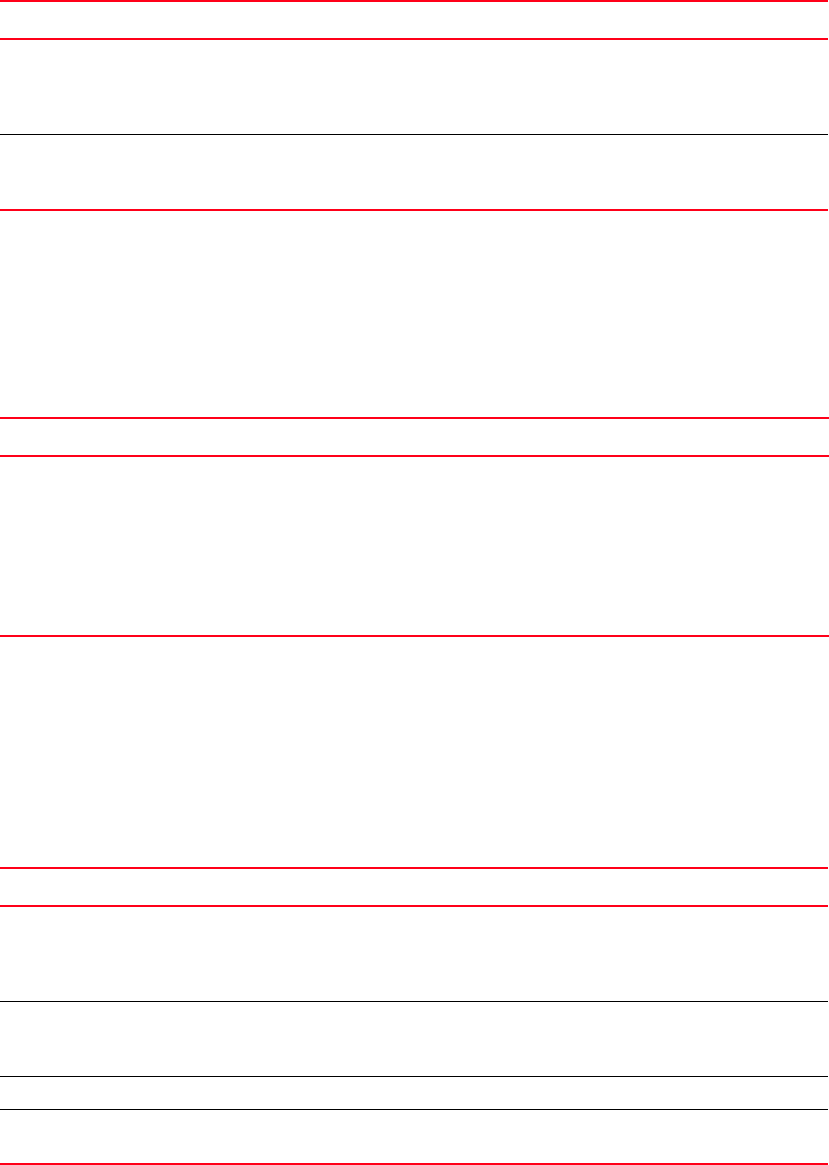Brocade Converged Enhanced Ethernet Administrator's Guide v6.1.2_cee (53-1001258-01, June 2009)
Table Of Contents
- Contents
- Figures
- Tables
- About This Document
- Introducing FCoE
- Using the CEE CLI
- In this chapter
- CEE CLI configuration guidelines and restrictions
- Using the CEE command line interface (CLI)
- CEE CLI RBAC permissions
- Accessing the CEE CLI through the console interface or through a Telnet session
- Accessing the CEE CLI from the Fabric OS shell
- Accessing CEE CLI command modes
- Using CEE CLI keyboard shortcuts
- Displaying CEE CLI commands and command syntax
- Using CEE CLI command completion
- CEE CLI command syntax conventions
- Using CEE CLI command output modifiers
- Configuring VLANs Using the CEE CLI
- In this chapter
- VLAN overview
- Ingress VLAN filtering
- VLAN configuration guidelines and restrictions
- Default VLAN configuration
- VLAN configuration procedures
- Enabling and disabling a CEE interface
- Configuring the MTU on a CEE interface
- Creating a VLAN interface
- Configuring a VLAN interface to forward FCoE traffic
- Configuring a CEE interface as a Layer 2 switch port
- Configuring a CEE interface as an access interface or a trunk interface
- Configuring VLAN classifier rules
- Configuring VLAN classifier groups
- Associating a VLAN classifier group to a CEE interface
- Clearing VLAN counter statistics
- Displaying VLAN information
- Configuring the MAC address table
- Configuring STP, RSTP, and MSTP using the CEE CLI
- In this chapter
- STP overview
- RSTP overview
- MSTP overview
- STP, RSTP, and MSTP configuration guidelines and restrictions
- Default STP, RSTP, and MSTP configuration
- STP, RSTP, and MSTP configuration procedures
- STP, RSTP, and MSTP-specific configuration procedures
- STP and RSTP-specific configuration procedures
- RSTP and MSTP-specific configuration procedures
- MSTP-specific configuration procedures
- 10-Gigabit Ethernet CEE interface-specific configuration
- Global STP, RSTP, and MSTP-related configuration procedures
- Clearing STP, RSTP, and MSTP-related information
- Displaying STP, RSTP, and MSTP-related information
- Configuring Link Aggregation using the CEE CLI
- Configuring LLDP using the CEE CLI
- Configuring ACLs using the CEE CLI
- In this chapter
- ACL overview
- Default ACL configuration
- ACL configuration guidelines and restrictions
- ACL configuration procedures
- Creating a standard MAC ACL and adding rules
- Creating an extended MAC ACL and adding rules
- Modifying a MAC ACL
- Removing a MAC ACL
- Reordering the sequence numbers in a MAC ACL
- Applying a MAC ACL to a CEE interface
- Applying a MAC ACL to a VLAN interface
- Clearing MAC ACL counters
- Displaying MAC ACL information
- Configuring QoS using the CEE CLI
- Configuring FCoE using the Fabric OS CLI
- Administering the switch
- Configuring RMON using the CEE CLI
- Index

Converged Enhanced Ethernet Administrator’s Guide 99
53-1001258-01
ACL configuration procedures
7
Removing a MAC ACL
To remove a MAC ACL, perform the following steps from Privileged EXEC mode:
Reordering the sequence numbers in a MAC ACL
You can reorder the sequence numbers assigned to rules in a MAC ACL. Reordering the sequence
numbers is useful when you need to insert rules into an ACL and there are not enough available
sequence numbers.
To reorder the rules in a MAC ACL, perform the following task from Privileged EXEC mode:
Applying a MAC ACL to a CEE interface
Ensure that the ACL that you want to apply exists and is configured to filter traffic in the manner
that you need for this CEE interface. An ACL does not take effect until it is expressly applied to an
interface using the access-group command. Packets can be filtered as they enter an interface
(ingress direction).
To apply a MAC ACL to a CEE interface, perform the following steps from Privileged EXEC mode:
Step Task Command
1. Enter global configuration mode. switch#config t
Enter configuration commands, one per
line. End with CNTL/Z.
switch(config)#
2. Specify the ACL that you want to remove. In this
example, the extended MAC ACL name is
“test_02.”
switch(config)#no mac access-list
extended test_02
switch(config)#
Task Command
Assign sequence numbers to the rules contained in the
MAC ACL. The first rule receives the number specified by
the starting-sequence number that you specify. Each
subsequent rule receives a number larger than the
preceding rule. The difference in numbers is determined
by the increment number that you specify. The
starting-sequence number and the increment number
must be in the range of 1 through 65535.
switch#resequence access-list mac
access-list_name
starting_sequence_number
increment_number
Step Task Command
1. Enter global configuration mode. switch#config t
Enter configuration commands, one per
line. End with CNTL/Z.
switch(config)#
2. Specify the CEE interface (interface 0/1 is used
in this example).
switch(config)#interface
tengigabitethernet 0/1
switch(conf-if-te-0/1)#
3. Configure the interface as a Layer 2 switch port. switch(conf-if-te-0/1)#switchport
4. Specify the MAC ACL that is to be applied to the
Layer 2 CEE interface in the ingress direction.
switch(conf-if-te-0/1)#mac
access-group access_list_name in










